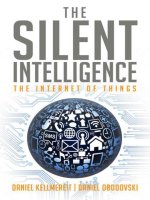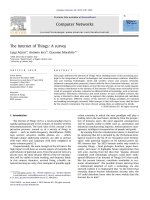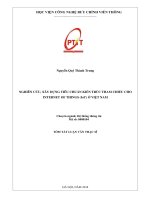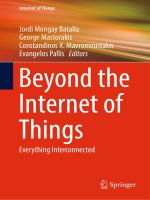Assignment 2 1690 Internet Of Things
Bạn đang xem bản rút gọn của tài liệu. Xem và tải ngay bản đầy đủ của tài liệu tại đây (1.61 MB, 26 trang )
ASSIGNMENT 1 FRONT SHEET
Qualification
TEC Level 5 HND Diploma in Computing
Unit number and title
Unit 43: Internet of Things
Submission date
28/10/2023
Date Received 1st submission
Re-submission Date
28/10/2023
Date Received 2nd submission
Student Name
Tran Duc Long
Student ID
GCH210562
Class
GCH1106
Assessor name
Le Anh Ngoc
Student declaration
I certify that the assignment submission is entirely my own work and I fully understand the consequences of plagiarism. I understand that
making a false declaration is a form of malpractice.
Student’s signature
Grading grid
P5
P6
P7
M5
M6
D3
D4
Summative Feedback:
Resubmission Feedback:
2.1
Grade:
Assessor Signature:
Internal Verifier’s Comments:
Signature & Date:
Date:
Table of Contents
A.
Introduction ............................................................................................................................................ 4
B.
Task 1: Develop the IoT application (P5-P6-M5) .................................................................................... 5
I.
Employ an appropriate set of tools to develop your plan into an IoT application. ............................ 5
1.
Overview .......................................................................................................................................... 5
2.
Select an appropriate set of tools to develop your plan ................................................................. 6
3.
Develop the solution........................................................................................................................ 8
II.
C.
Video and test product ...................................................................................................................... 15
1.
Product........................................................................................................................................... 15
2.
Website .......................................................................................................................................... 16
3.
The perfect and incomplete points in our system......................................................................... 20
Task 2: Test and Evaluate the user feedback (P7 – M6) ....................................................................... 20
1.
Run end user experiments and examines feedback ......................................................................... 20
2.
Evaluate end user feedback from your IoT Application .................................................................... 23
D. Conclusion ............................................................................................................................................. 25
Table of Figure
Figure 1: Framework ESP8266........................................................................................................................ 7
Figure 2: Framework adafruit ......................................................................................................................... 7
Figure 3: Demo products .............................................................................................................................. 10
Figure 4: Hosting service of our project ....................................................................................................... 14
Figure 5: All files in my website project ....................................................................................................... 15
Figure 6: Example source code PHP in project website ............................................................................... 15
Figure 7: Final product.................................................................................................................................. 16
Figure 8: Home page .................................................................................................................................... 17
Figure 9: Health monitor page ..................................................................................................................... 18
Figure 10: HistoryLog page ........................................................................................................................... 18
Figure 11: Contact page................................................................................................................................ 19
Figure 12: Feedback of user from website ................................................................................................... 19
Figure 13: Product introduction and calculation formula ............................................................................ 20
A. Introduction
In Assignment 1, I explored IoT platforms, tools, and hardware while elucidating the
fundamental principles of IoT. This report aims to implement the solutions outlined in the
previous document for the identified problem. Subsequently, I will gather feedback from
project participants and evaluate the ultimate outcome.
B. Task 1: Develop the IoT application (P5-P6-M5)
I.
Employ an appropriate set of tools to develop your plan into an IoT
application.
1. Overview
a. Problem
In today's rapidly evolving technological landscape, there is a continuous push
towards advancements, particularly in the realm of the Internet of Things (IoT).
These advancements are driven by the pressing need to address various human
requirements. IoT technology has found extensive applications across a wide array
of sectors and industries, including areas such as agriculture, transportation, and
education. However, one notable and recent example that vividly underscores the
importance of IoT is its deployment in the field of epidemic prevention.
In particular, IoT has played a crucial role in safeguarding the health of a significant
population, especially in the context of diseases like Covid-19. Given the serious
nature of such illnesses, we have taken proactive steps to develop a product that
integrates IoT functionalities. This product is specifically designed for monitoring
essential physiological parameters, specifically heart rate and blood oxygen levels.
By enabling users to continuously track these vital metrics, our innovation serves
as a proactive tool for monitoring cardiovascular health and oxygen levels in the
blood. This, in turn, allows for timely medical intervention in cases of emergency.
It is worth noting that a common symptom of Covid-19 is a decrease in blood
oxygen levels, which, if not addressed promptly, can lead to respiratory distress
and, in severe instances, even mortality.
b. Solution
To effectively tackle the challenge mentioned earlier, our team has developed
and implemented a solution involving a device designed for monitoring both
heart rate and blood oxygen levels. This innovative device has been carefully
crafted to meet the specific requirements associated with these medical
conditions, allowing individuals to easily assess their health status. Notably,
this device not only has the ability to collect relevant data regarding heart rate
and blood oxygen levels but also features the capability to promptly send
notifications to the patient, their family members, and the attending medical
professional for swift follow-up and intervention. It's essential to highlight that
even beyond the current epidemic situation, this technology remains a
valuable asset in the healthcare sector, providing ongoing support and
significant potential for future enhancements and advancements.
2. Select an appropriate set of tools to develop your plan
Our team has opted for an IoT application centered around monitoring heart rate
and blood oxygen levels. This application will encompass two key features: a heart
rate sensor and a blood oxygen level sensor. The data collected from these sensors
will be transmitted to a website via the HTTP protocol for analysis and to issue
warnings based on the user's heart rate and SpO2 severity.
The initial step in bringing this program to life involves selecting an Integrated
Development Environment (IDE) for source code development, program
debugging, and code compilation. Our team has chosen the Arduino IDE for this
project because it operates on a microcontroller, a compact computer capable of
running a single program continuously. This setup provides a user-friendly circuit
board for managing repetitive tasks, such as heart rate monitoring and sensor
runtime control. To monitor and control the device remotely, we'll need a
platform or API. We've decided to use the free domain name registration and
hosting service provided by 000webhost due to its simplicity and affordability. This
service will serve as the primary server and enable us to create a dynamic website
interface that facilitates data transmission via the HTTP protocol, accessible on
various devices wherever internet connectivity is available.
As 000webhost is a free hosting service, we have the flexibility to utilize PHP and
MYSQL source code, along with technologies like HTML, CSS, JS, AJAX, and JQUERY,
to craft a comprehensive website with the ability for customization. This will allow
us to control the system and test devices via the internet. Thus, we've chosen to
integrate the Arduino IDE with the C++ programming language and 000webhost to
construct the system. The Arduino Software (IDE), which is free and open source,
simplifies data encoding and uploading to the website. This IDE can be used with
any Arduino board.
Framework:
•
ESP8266
A collection of modules called the ESP8266 IoT Framework can be used as a basis
for new ESP8266 projects. It implements OTA updates, WiFi management, a React
web interface, HTTPS requests, and a live dashboard.
The framework consists of five key components: a web server, including classes for
handling HTTP requests and OTA updates, a WiFi manager, a configuration
manager, and the user interface it supports. The diagram provided below offers a
visual representation of the framework's structure.
Figure 1: Framework ESP8266
The development of this framework was guided by the following fundamental
principles:
-
The framework is built upon the ESP8266 Arduino libraries.
It does not include features for controlling external hardware.
The framework is designed for straightforward deployment as it is selfcontained and does not rely on LittleFS or SPIFFS storage.
It maintains a strict separation between the web interface via an API and the
ESP8266 application.
By utilizing this framework, the device can collect user data, transmit it to a server,
and perform health diagnostics to notify the user or their family members about
their health condition.
•
Adafruit:
The device will utilize sensors to measure both blood oxygen levels and heart rate.
To achieve the desired functionality, we require the Adafruit framework. Adafruit
is well-known for offering open-source libraries and hardware compatible with a
wide range of microcontrollers and sensors, including the ones utilized by our
team.
Figure 2: Framework adafruit
Hardwares of this IoT project:
Name
ESP8266
Image
Max30100
Display
Oled 0.96
inch
Breadboard
Description
The ESP8266 is a Wi-Fi module
capable of connecting to the Internet
and is commonly used to implement
IoT applications. It helps us connect
with Max30100 sensor and other
device to collect data like oled screen.
Which then allows me to stream the
data to the web server.
The MAX30100 is a popular integrated
pulse oximetry and heart-rate monitor
sensor module. It is commonly used
for non-invasive measurement of
heart rate and blood oxygen
saturation (SpO2). The MAX30100
sensor utilizes red and infrared light
to measure the amount of oxygen in
the blood and detect heart rate.
A 0.96-inch OLED display is a small
organic light-emitting diode (OLED)
screen that measures 0.96 inches
diagonally. These displays are known
for their high contrast, excellent color
reproduction, and low power
consumption. We use them to display
the measurement data of the
Max30100 sensor on the screen
A common term for an electronics
prototyping platform is a breadboard
or protoboard, which is employed for
linking wires to hardware.
3. Develop the solution
All of the mentioned hardware components will form an interconnected smart
heart rate monitoring system, accessible through a WiFi connection. Since the
entire system will operate online, users can conveniently assess its functionality
and performance prerequisites using various smart devices like computers,
smartphones, tablets, or other similar gadgets by simply visiting the following web
link: />Utilizing this hardware, the smart heart rate monitoring system will gather data
regarding an individual's heart rate and blood oxygen levels. This data will then be
transmitted via the Internet to the 000Webhost server. Subsequently, an API will
process this data and relay it back to the user's computer, which is responsible for
displaying the information on the project's website interface. This interface allows
access through a range of internet-connected devices, including smartphones,
tablets, laptops, and more.
Pulse Oxygen Measurement: The MAX30100 sensor measures blood oxygen
saturation (SpO2) and heart rate by shining light through the skin and measuring
the amount of light absorbed by oxygenated and deoxygenated hemoglobin. The
MAX30100 communicates with the microcontroller and other devices using the
I2C communication protocol. So we have developed and integrated into Internet
of Things (IoT) applications for remote health monitoring, allowing real-time data
transmission. Its data will be displayed on the OLED screen and on our hospital
website, on the website heart rate parameters data will be analyzed and given
high, low, normal warning status.
Hardware configuration:
The assembly of the MAX30100 Pulse Oximeter Webserver on a NodeMCU is
straightforward. The MAX30100 Oximeter Sensor operates through the I2C bus, so
you just need to link the I2C pins (SCL and SDA) of the oximeter module to the D1
and D2 pins on the NodeMCU. Connect the INT pin to the NodeMCU's D0 pin.
Likewise, supply 3.3V power to the VCC and ground the GND pin. After finishing
config, we have product:
Figure 3: Demo products
Source code/Program:
I use Arduino sketch that interfaces with a MAX30100 Pulse Oximeter sensor and
an OLED display, and it sends the sensor data to a remote server over Wi-Fi. These
are the libraries I use in the project:
These lines include several libraries required for the project. These libraries
provide functionality for I2C communication, OLED display control, Wi-Fi
connectivity, and interfacing with the MAX30100 Pulse Oximeter sensor
.
• Constants and Variables:
These are constant values defining the reporting period for sensor data (600
milliseconds), the interval for sending data to the server (15 seconds), and a delay
after sending data (0.5 seconds).
Here, I have constants and variables for averaging sensor data. The code buffers
the last AVERAGE_COUNT sensor readings for heart rate (BPM) and SpO2 levels.
These lines define the Wi-Fi network name (SSID), password, and the URL of the
server where data will be sent. It also specifies an API key and the name of the
sensor.
• Objects:
These are object declarations:
•
display is an OLED display object with a resolution of 128x64 pixels.
pox is an object for the MAX30100 Pulse Oximeter.
https is an HTTP client object for making secure HTTP requests.
setup() Function:
•
The setup function is executed once when the Arduino starts. It initializes the
serial communication, connects to Wi-Fi, initializes the display, and sets up the
sensor.
loop() Function
The loop function is the main execution loop. It continuously reads data from
the sensor, displays the data, and sends it to the server at specified intervals.
•
Other Functions:
initializeDisplay(): Sets up and initializes the OLED display.
initializeSensor(): Initializes the Pulse Oximeter sensor.
gettingSensorData(): Updates and processes data from the sensor.
displaySensorData(): Displays sensor data on the OLED screen.
sendDataToServer(): Sends the BPM and SpO2 data to the remote server using
an HTTP POST request.
The code implements a basic IoT setup to collect and send pulse oximeter data
to a remote server via Wi-Fi. The sensor data is displayed on an OLED screen.
This code assumes that you have the required hardware components and
libraries installed for the project to function properly.
•
HTTP Website:
My task in the group is to design the website for this project. Therefore, I chose
the 000Webhost server hosting service to push my website to the host so users
can access it via the internet application. I use PHP, MySQL source code along with
technologies such as CSS, Boostrap, JQuery, AJax to create a complete website
called Hospital.
Figure 4: Hosting service of our project
Figure 5: All files in my website project
Figure 6: Example source code PHP in project website
II.
Video and test product
By closely following the connectivity guidelines described earlier and using the provided
code, the device is ready to function without any issues. A product demonstration is
available through Google Drive; to access it, please click on the link provided.
1. Product
Here we introduce our team's groundbreaking product called the 'Heart Rate Sensor.'
By placing your finger on the device's red light emitter (MAX30100), it swiftly records
your current heart rate and oxygen levels in real-time. These crucial data points will
then be displayed on the device's screen for user convenience and monitoring.
Figure 7: Final product
Moreover, the data will be sent to a web server at 15-second intervals, enabling
others to access it by visiting a designated website.
2. Website
When users access the website link:
/>The screen will move to the following interface. Here users can explore website
information, view the history of measurements, or see an introduction to the website,
or can send feedback to us right on the website.
Figure 8: Home page
When the user clicks on the health monitor section on the home page, they will be redirected to
the monitoring interface, where the user will see someone's 5 most recent measurements. This is
where website data is displayed. When the user places their hand on the product's sensor, the
data will be displayed on the screen and pushed to this website.
Figure 9: Health monitor page
When the user clicks on the health log section on the home page, the user will be
redirected to the history log page, which will display all the measurement schedules of
the product user so far.
Figure 10: HistoryLog page
When users click on the word contact on the navbar, they will be redirected to the contact page,
where they can contact us, as well as review the product. These feedback will be sent to my email
for me to read and provide a complete solution for the website.
Figure 11: Contact page
Figure 12: Feedback of user from website
In addition to the above 3 pages, users can also click on the word learn More or the patient
section to take a closer look at the website and products.
Figure 13: Product introduction and calculation formula
3. The perfect and incomplete points in our system.
Perfection: Supporting the progress of the solution, the system will have certain
benefits and limitations. The first value of technology is to help customers
manipulate the environment with precise numbers and monitor health remotely
and via the Internet. From the status of measurements on the website, they can
know their health status and go to medical centers. This system is intuitive yet
useful, providing many benefits.
Non-Flaws: There are a number of nits, including the possibility of system failure
without any warning to the user. Using an internet connection that is too weak or
having many people accessing the website will cause the website to be delayed.
This is an issue that we must consider to fully develop the system.
C. Task 2: Test and Evaluate the user feedback (P7 –
M6)
1. Run end user experiments and examines feedback
In this portion, I will delve into the user feedback information gathered through a Google
Form survey to gain deeper insights into what users think about our product.









